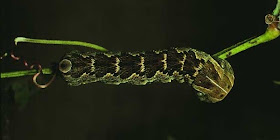Eumorpha labrusace (Sphingidae)
 |
| Eumorpha labruscase caterpillar, penultimate instar. Closely related to Eumorpha phobas. Note the red anal horn which can be moved actively when the caterpillar feels threatened. Photo from Janzen and Hallwachs' database. |
Early Instars:
The specimen in the photo at the top has not yet reached its final instar where it will gain the blinking eyespot. Instead, it has a long red anal horn that it can flick or whip back and forth. The anal horn is actually soft and harmless, its purpose is probably to intimidate or bluff predators away from attack. While it is waving this horn the caterpillar simultaneously pulls its head into its body telescopically. This widens its anterior body segments which have false eyes (eyespots) and creates the overall impression of a snake's head. I have embedded a short video clip of the defensive display below:
I have never seen a specimen in an earlier instar than this (i.e. a pre-penulitimate instar caterpillar), not even a photo of one. I would guess that they looks similar to the the early instars of Eumorpha phorbas (see them here). A note from the database record for the specimen at the top states that the "...PPU instar looks like normal Eumorpha satellitia..."
Ultimate instar:
Yes, the caterpillar is quite impressive in the early instar depicted above, but the final caterpillar instar of this caterpillar is equally impressive. The specimen at the top is the same specimen depicted below. It was found after a tree fall in 1978 feeding on a woody vine (Cissus alata). As with E. phorbas, feeding on these canopy-level vines may help explain why these caterpillars are observed so infrequently. Other specimens have been found feeding on C. biformifolia, C. fuliginea and C. verticillata. Apparently the caterpillars also feed on another closely related group of vines in the genus Vitis, including the species Vitis labruscae where the species name may haveprobably come from. The caterpillars get quite large by this stage reaching sizes around 80 mm. |
| Eumorpha labruscae caterpillar, ultimate instar. Costa Rica. Caterpillar is in its defensive posture. Photo from Janzen and Hallwachs database. |
As you can see, the caterpillar keeps many of their snake-like characteristics from the earlier, like the eyespots on the body segments near the caterpillars real head. Even when walking around this caterpillar appears to be a pretty convincing snake mimic (at least to human eyes). It also sheds the long red anal horn, which is now replaced by a shiny black spot that it can actively move. Here is a closer look at the posterior "blinking" eyespot of Eumorpha labruscae:
 |
| Posterior "blinking" eyespot of Eumorpha labruscae caterpillar, ultimate instar. Costa Rica.Photo from Janzen and Hallwachs database. |
By moving this black spot on its posterior (rear) end the eyespot appears as though it were a blinking eye. The caterpillar actively "blinks" this eyespot when threatened, and we think that this "blinking" eyespot is meant to scare off attackers. Interestingly though, snakes don't have eyelids (they have transparent eye scales called brilles instead) and therefore do not blink! So then what is this "blinking" eyespot mimicking? We suspect that it is perceived by predators as a blinking eye of some other vertebrate, perhaps the eye of a lizard, mammal, or bird that does blink. It could be that the caterpillar mimics a snake from the anterior end, and by mimicking a different kind of eye at the posterior end the caterpillar increases the range of predators that it is protected from. As I have mentioned these caterpillars are only rarely encountered, so unfortunately this means we have not yet had a chance to determine how the relevant predators react to the "blinking" eyespot.
I have embedded two great videos of the ultimate instar caterpillar in action. The first clip shows off the anterior eyespots and the snake-like head, and the second one shows the blinking eyespot really well:
Adult:
The adult life stage of this species is actually quite handsome. Their wingspan ranges from at least from 85-115 mm. The colour of the underwings is presumable where the species gets its common name - the Gaudy Sphinx. The species occurs throughout Central America, but also extends northward through the United states (sometimes up to Saskatchewan and Manitoba, Canada), and southward occasionally as far as Argentina.
 |
| Eumorpha labruscae adult male. Cost Rica. Wingspan: 111 mm Photo from Janzen and Hallwachs database. |
 |
| Eumorpha labruscae adult male. Cost Rica. Wingspan: 115 mm Photo from Janzen and Hallwachs database. |
Find out more about "blinking" eyespots or Eumorpha labruscae by following the links below:
A more complete description of the "blinking" eyespot in Eumorpha labruscae and its close relative E. phorbas as well as our thoughts on this eyespot's possible function in deterring predators can be found in our recent manuscript published in the Journal of Natural History:
No comments:
Post a Comment